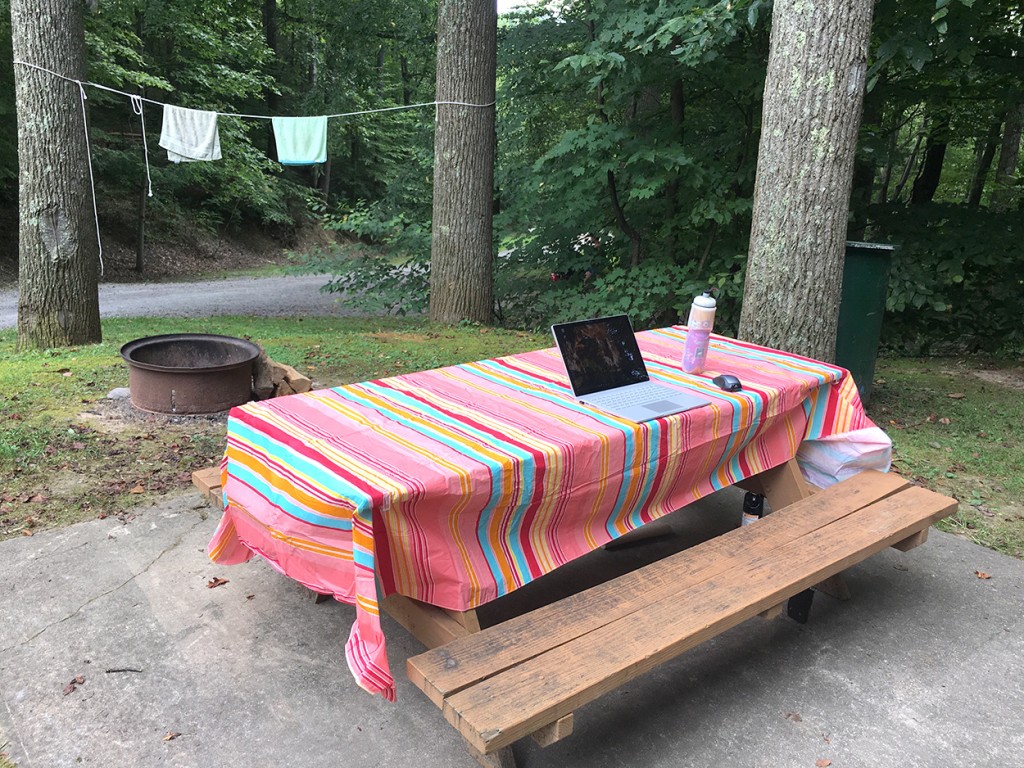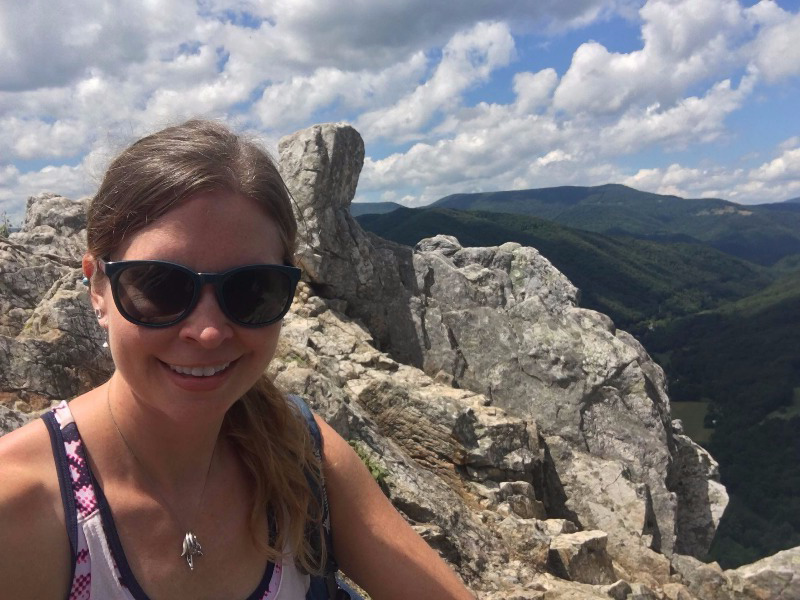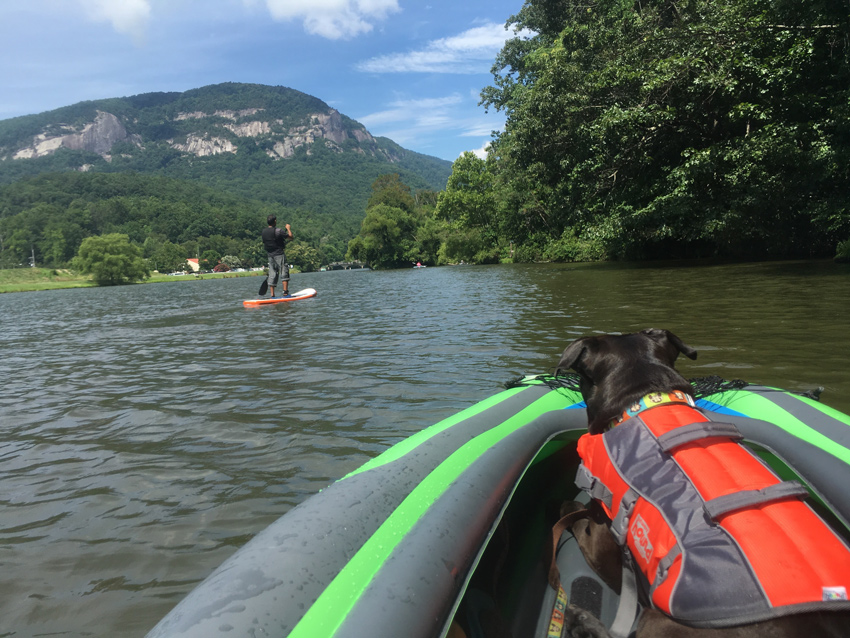by Alyssa L. Ochs
On July 14, my husband, dog, and I set out on the adventure of a lifetime. We had been living in Atlanta for a while, but our apartment lease was up and the timing felt right to make a big change. So we set out on a full-time camper life adventure to give nomadic life a try while working from the road and exploring the country.
Over the past couple months, I’ve gotten a lot of questions about how this kind of lifestyle actually works from worried family members, envious friends, and curious strangers. We’re not new to long-term travel, or camping for that matter, but this trip feels different. It has no end date, and there’s no place to go back to. These are concepts that don’t sit well with some people, but for me, it beats looking at the same four walls in an apartment day after day.

So whether you think living out of a pop-up camper is crazy, exciting, or a little bit of both, here’s what I’ve learned so far about planning an adventure that isn’t bound by an address.
Figuring Out the Logistics
Initially, the most intimidating thing about living on the road for an undetermined amount of time was sorting out the logistics. Where would we forward our mail? What would we do with our furniture? How would we renew our car license registrations?
I tend to get overwhelmed by little details like this when they all come at once, but the key is to make a list early and check them off one by one. Step one was to start downsizing. We did an evaluation of everything in our apartment and made decisions about what to keep, sell, and donate. I posted ads on local Facebook garage sale groups and Craigslist to offload some stuff and took a few loads to a nearby charity. We rented a 10-foot by 12-foot storage space and began separating the remaining stuff into piles of whether it would come with us on the trip or be stored away. Since we have the tiniest pop-up camper on the market, about 90 percent of the remaining stuff went into storage.
For some silly reason, the government requires you to have an address of some sort on file, and my husband’s business partner agreed to let us use his. We switched all our bills over to electronic versions, cancelled other mailings, set up mail forwarding, and notified relevant places like credit card and retirement account companies about the new address.
Deciding What to Pack
It was mid-summer when we left, which made packing light and easy. All of the clothes I wear these days fit into a small carry-on-style wheeled suitcase, and I fit 14 outfits in there. From the beginning, I knew that we’d be spending most of our time hiking, kayaking, SUPing, rock climbing, and bumming around the campground. But I also wanted to have a couple nicer things in case we went out to dinner in a city or met up with old friends.
So within those 14 outfits, I chose a mix of running clothes, hiking clothes, water sport clothes, comfy shorts and t-shirts, and casual dresses and skirts. For shoes, I brought hiking boots, running shoes, hiking sandals, casual flats, and a pair of flip-flops. We’re planning to swing back by the storage unit as fall sets in to swap out some stuff.
Other than clothes, we knew that we’d be cooking a lot at the campground to save money and eat healthy. Our pop-up camper has a mini-fridge, a three-burner stove, and small sink. The storage in this thing is very limited, but we managed to squeeze in a set of pots and pans, plastic dishes, silverware, and coffee mugs. Don’t forget to bring a couple sets of towels and sheets to swap them out because finding laundry facilities in campgrounds and laundromats in small towns can be challenging.
One difficult thing to decide on was what sporting equipment to bring. We really wanted to bring our bikes (our dog even has her own bike trailer to ride in!), but my Jeep could only accommodate either water sports equipment or bike equipment. For better transportability, we invested in an inflatable kayak and an inflatable SUP a while ago. They’re a pain to pump up by hand, but they save a ton of space. We actually installed a storage rack above the back tire of the Jeep to haul the inflatable water sport bags. We’ll swap out water sports for bikes in the fall.
Toiletries take up a lot of room, but travel-sized bottles will cost you a lot more in the long run. So pick up a container to store your big bottles in and small empty containers to refill with your bath products over time. I’m no girlie girl, but having my bath products and favorite jewelry makes me feel normal and nice.
It’s hard to keep up with your favorite hobbies while living on the road, but don’t entirely abandon the things you love. I enjoy sewing, but since I can’t bring my sewing machine in a camper, I started cross-stitching. I used to play piano, but I started teaching myself guitar because it’s a more portable instrument. And when I’m feeling artistic, I pull out my small sketchbook and a watercolor paint postcard set. Postcards are old-school, but they’re a really fun way to stay in touch with people from the road.
Securing Steady Work
If you can’t pay for your campsites, your on-the-road journey isn’t going to last very long. Fortunately, both my husband and I have remote working jobs that are well-established and that we can do from anywhere. I’ve been full-time freelance writing for over 3 ½ years now and have a steady base of clients who send me writing assignments on a regular basis.
I’ve read lots of nomadic traveler blogs from people who somehow manage not to work or who just pick up odd jobs along the way when they travel. This may be great for them, but it’s not for me. I wouldn’t recommend setting out on a trip like this unless you have a steady means of supporting yourself, or at least an unwavering confidence that you really will figure it out along the way.
Most days, my husband and I put in eight-hour work days at the campsite, just like we would from a house or office. The key is watching the weather and planning your other activities around work to maintain balance. If it’s going to rain the morning but clear up the rest of the day, get up early and do your work first thing in the day. Then you can cut out by mid-afternoon and go to the lake or trailhead. Weekend work may be needed to make up for lost time, and if you can work as a car passenger without getting nauseous, that’s a great way to make the most of travel time.

This style of work requires a tremendous amount of self-discipline, but it’s easy to fall into a routine of working on the road just like anywhere else. Honestly, the biggest working challenge for me hasn’t been finding focus, but rather finding reliable internet. We have a Wi-Fi hotspot on one network and smartphone hotspots on another, and we try to stay in campgrounds with free Wi-Fi, but getting reception is sometimes easier said than done in remote areas. You may have to take turns going to coffee shops, fast food restaurants, or even laundromats with Wi-Fi to complete high bandwidth assignments.
Mapping Your Route
In the beginning of a trip like this, one of the most exciting things is figuring out where you’ll go next because everything’s a viable option. But after a while, it becomes exhausting having to research where you’ll sleep next and how you’ll spend your days.
If you’re traveling with someone else, it’s important to divvy up that research work so that one person doesn’t get burnt out and feel like calling it quits. You’ll drive yourself crazy if you try to plan out every little detail, but it’s also stressful to show up in a new place and be disappointed. Especially during the summer season, it’s a smart idea to book campgrounds at least a couple weeks in advance so they aren’t booked up. More advance planning than this usually isn’t necessary unless you have somewhere really specific and popular in mind to stay.
Then save your activities research for the drive there, or even when you arrive. One of my favorite ways to find things to do in new places is to pick up free publications from shops in town about local events to see what’s going on and being advertised nearby.
Choosing Campgrounds
Online reviews are only as helpful as the people who write them, and most people who camp aren’t traveling like we are. As I write this today, we are staying at our 10th campground of this trip, and we’ve stayed at some very good and some very bad places. No matter how many reviews you read, you really just don’t know what you’re going to get with a campground until you show up.
Keep in mind that not all campgrounds are created equal, and there’s a lot of variance among them no matter where you are. Private campgrounds often have long-term and permanent residents that gives them a trailer park vibe. Meanwhile, state and national park campgrounds often have a 14-day limit. Private campgrounds sometimes have cleaner bathrooms and more amenities, while state and national park ones tend to be closer to trails and cheaper. It’s all about personal preference, so try a few different types to see which one suits your camping style best.
Our priorities in choosing a campground include sites that aren’t too close together, shaded sites, level sites, Wi-Fi access, clean bathrooms, laundry facilities, and accessibility to outdoor activities. To help my fellow travelers, I’ve been leaving Google reviews of every campground we stay at, and I’ll continue to do so for future ones too.
Accommodating Your Dog
About seven months ago, my husband and I adopted a black lab/pit bull mix from the county animal control shelter in Atlanta and named her Monkey. If you spend just two minutes with this two-year-old ball of energy, you’ll understand how she got her name.
Monkey has added a whole other element to our travels, and it hasn’t always been easy. In terms of planning, you need to find accommodations that allow dogs, dog-friendly restaurants and bars, pet stores that stock her fancy salmon and grain-free food, dog parks, and self-wash stations for much-needed baths.
Not all dogs travel well on road trips, and some get motion sickness every time they’re in a moving vehicle. Fortunately, Monkey is a wonderful passenger and complains about long rides far less than we do.
Yet traveling with a dog takes additional research and phone calls to confirm whether dogs are allowed in certain places. Having a dog limits what you can do at times, but it also keeps you active and makes you get creative by taking turns going into places. Dogs tend to be social creatures, even if you’re not. So you may need to factor social time with other dogs into your travels to keep yours sane even if you don’t feel like it.
Acknowledging Your Personality
You learn a lot about yourself and your travel style when you’re on the road full-time, and it’s better to learn those lessons early so you can adjust your trip to suit your personality. If you’re an extrovert, you may crave random interactions with new neighbors in your campground and in bars you stop by. But if you’re an introvert, you may prefer to explore and observe new places on your own and take solo outings to process your experience.
For example, this trip has reinforced for me that I don’t do well with crowds but that I’m not too squeamish to kill bugs of all kinds. Monkey has forced me to become more of a morning person than I’d ever choose to be because she wakes up way too early, but that helps me get more work done so I guess I’ll forgive her!
Overcoming Challenges
If you take a look at my weekly “Home on the Road” Facebook updates, you might think that life on the road is all daisies and roses. But just remember that social media only shows one tiny sliver of an experience like this. I don’t pretend for a moment that this trip hasn’t come with its fair share of challenges already. We’ve dealt with steady temperatures over 100-degrees, a leaky air conditioner, an ant infestation in the camper, an infection that led to an urgent care visit, camping next to a landfill, a plethora of bug bites, mildew, water damage, and counties that don’t’ sell beer on Sunday. All of these things inevitably lead to arguments, crankiness, and wondering why you chose this lifestyle at all.
But it’s important to remember that challenges come up no matter where you live. Our challenges are different than they would be if we lived in a house, but they’re challenges just the same. The types of things that frustrate you will continue to do so no matter where you lay your head at night, but trips like this make you more tolerant, resilient, and open-minded over time.
Embracing the Spontaneity
But despite these challenges, I’d still choose this way of life over any other right now. At this time in my life, I’m not weighed down by responsibilities out of my control, but I realize this won’t always be the case. I try to remind myself of that sometimes and just appreciate the fact that I have this opportunity right now. No matter how spontaneous you think you are, you’ll still fall into comfortable routines on the road. Embrace those routines because they’ll keep you grounded and bring a sense of normalcy to your days.
So to wrap this up, my advice is to give camper life a try if you ever get the opportunity – even if it’s just for a couple weeks. It’ll help you live more minimally and mindfully, push you outside your comfort zone, maximize your time in the outdoors, and teach you things about yourself that you never knew.
After leaving Georgia, our route has taken us through North Carolina, Virginia, D.C., Maryland, Delaware, Pennsylvania, West Virginia, and Kentucky. We’ve stuck to the eastern U.S. thus far, but that’s all about to change. You can keep up with our future adventures, mishaps, and insights as we head south, then west, and eventually up the Pacific Coast on my blog, Alyssa v. Nature. I’m always open to any questions, comments, or encouragement you have to offer as this epic journey continues!



